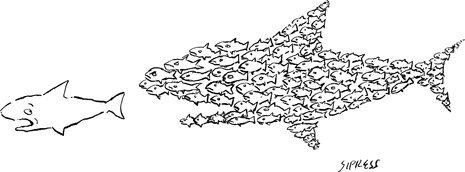A cartoon grabbed my attention while I was perusing the recent issue of the New Yorker.
courtesy of The New Yorker– you can find it’s cartoon bank entry here
I thought I’d seen this before. The concept itself is pretty generic, but… hadn’t this already been a New Yorker cartoon?
courtesy of The New Yorker– you can find its cartoon bank entry here
I would have been too young to have seen O’brien’s original cartoon, as it was published October 28, 1991. There’s a chance I’ve caught a reprinting of it. More likely, I’m as used to the concept as everyone else, demonstrated by the variety of “small fish eat big fish” images uncovered on a google image search.
While not ubiquitous, I’d say that the small-fish-forming-into-bigger-fish-and-chasing-predator is an established visual metaphor. It’s interesting to see that the small-fish-forming rarely occurs without the chasing/eating of the bigger fish (can they eat the bigger fish?) The pressure to group together is always a retaliation to predation. Additionally, while the motif has a satisfying punch line, it doesn’t seem like its primary function is to be funny. Typing in “organize fish,” brings up a decent amount of these cartoons with an anti-capitalist bent, where the concept is put across motivationally or strategically. Most of the fish images look like infographics, and a quick survey reveals their sources to be editorial blogs or stock-photo sites, (perhaps most revealing.)
Perhaps the New Yorker cartoon editor should have paid attention to the fact that this image isn’t very funny. Alternatively, he or she might have liked the fact that the cartoon’s commentary outweighs it’s laugh-factor, even though its message is more hopeful than truthful. Finally, the editor might have approved it because it just seemed like something the New Yorker would publish, which is actually the case.
Comparing the cartoons, I prefer the O’brien image. O’brien’s execution of the little fish is more whimsical, and he doesn’t require plankton or sea-monkeys to fill out the fins. The remorseless ambiguity of the predator’s expression is nice– perhaps he looks surprised, but fish look that way all the time. O’brien’s rendering of the sea-floor makes his cartoon less conceptually clean, but as money managers and Occupiers convert the idea into a truism, a slogan, I prefer it messy and maximalist. His use of stipling reminds me of an old scientific etching. I wish he had pushed that more aggressively– rather than an inspirational ‘au contraire,’ the drawing would have illustrated the absurdity of this metaphor happening in nature. But that’s not really that funny or interesting either. Oh well.


